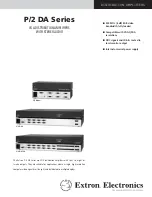
3
dc2078af
DEMO MANUAL DC2078A
OPERATION
The input and output DC blocking capacitors (C1, C2,
C7 and C8) are required because this device is internally
biased for optimal operation.
Frequency appropriate chokes (L1 and L2) and the decou-
pling capacitors (C9, C10, C11 and C12) provide bias to
the RF ±OUT nodes. Only a single 5V supply is necessary
for the V
CC
pins on the device.
Figure 2. Demo Board S-Parameters
Figure 3. OIM3 and HD2 vs Frequency
Demo circuit 2078A is a high linearity, fixed gain amplifier.
To configure the demo circuit 2078A for use in the 75Ω
CATV environment, a transformer with 1:1.33 impedance
ratio is added at the board’s input and output. These
transformers transform the differential 100Ω impedance
of the LTC6430-20 to single-ended 75Ω impedance. The
frequency range of the circuits is limited by the balun
transformers. Hence, the demo board has a nominal work-
ing frequency range from 50MHz to 1000MHz. Figure 2
shows the S-parameters of demo board.
Demo circuit 2078A is shipped with 75Ω F-type connec-
tors (J1 and J2) at both input and output. Depending on
the user’s preference, the board may also accept other
connector types such as BNC or SMA. Please note that
the use of substandard connectors can limit the usable
bandwidth of the circuit.
The input and output transformers (T3 and T4) convert the
differential signal to single-ended 75Ω signal for compat-
ibility with the CATV environment, while preserving all the
exceptional characteristics of the LTC6430-20. In addition,
the balun’s excellent phase balance and the second order
linearity of the LTC6430-20 combine to further suppress
second order products across the entire CATV band.
Figure 3 shows the spurious products (in dBc) within the
passband frequency 50MHz to 1000MHz. The output third-
order intermodulation (OIM3) and the second harmonic
distortion (HD2) are shown as a function of frequency.
Table 2. DC2078A Board I/O Descriptions
CONNECTOR
FUNCTION
J1 (IN)
Single-Ended Input. Impedance
Matched to 75Ω.
J2 (OUT)
Single-Ended Output. Impedance
Matched to 75Ω.
E1 (VCC)
Positive Supply Voltage Source.
E2 (GND)
Negative Supply Ground.
E3 (T_DIODE)
The measured voltage will be an indica-
tor of the chip junction temperature.
In this particular application circuit, the input stability
networks (C3, C4, R1, R2) are not required since the
LTC6430-20 is preceded by a low frequency termination
from the balun transformer. In a wideband differential
application where the bandwidth extends below 20MHz,
the input stability network is suggested.
FREQUENCY (MHz)
40
|S21| (dB)
22
20
16
12
8
4
18
14
10
6
2
0
240
DC2078a F02
1240
640
840
440
1040
|S11|, |S12|, |S22| (dB)
–44
–24
–20
–16
–8
–28
–32
–36
–40
–4
0
–12
|S22|
|S11|
|S12|
|S21|
FREQUENCY (MHz)
0
OIM3, HD2 (dBc)
–100
–70
–60
–40
–50
–20
600
800
DC2078a F03
–80
–90
–10
0
–30
200
400
1000
OIM3, P
OUT
= 1dBm/TONE
HD2, P
OUT
= 6dBm
OIM3
HD2





























